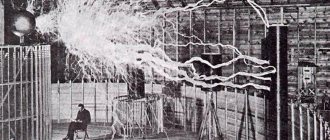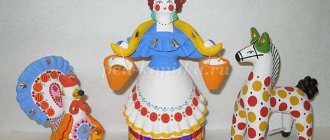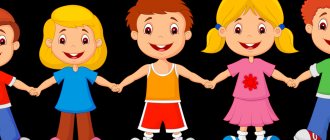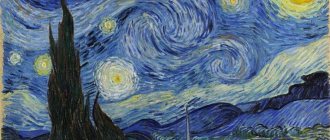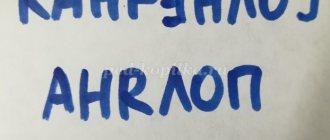Lesson summary:
- Pronunciation of new words increases the preschooler’s vocabulary, develops speech and memory.
- Cell exercises develop fine motor skills of the hands.
- Riddles develop children's intelligence, ability to analyze and prove. Teachers use riddles when teaching children to increase interest during complex tasks.
- Poems influence not only the development of memory. It has been proven that if you learn a few lines every day, new neural connections appear in the brain and your overall learning ability increases.
Goal: creating conditions for familiarization with the letter and sound Y.
Tasks:
Poems about the letter Y for children
Yula huddles under a bush, Yula spins around. But still, notice, Yula is such a bird. Whose gentle, thin voice is clear, like a violin, and high. (A. Pudval)
Praise be to young Yulia, Fast and nimble, like a top. And in June and July Yulia will rest in the south. (V. Berestov)
Yura just sat down on the chair, dangled his legs and fell asleep. Yura was very tired - Spinning around like a top all day. (F. Bobylev)
On the road, in an unknown land, the compass is our best friend. The south is marked with one capital letter Y. We're flying above the clouds, heading south on the compass. To the seashore, to the southern Crimea, where there are no blizzards in winter. (S. Marshak)
I sewed a skirt for the doll, I will make a new jacket. The doll tells me: “Mom!” So, I sew for my daughter. (G. Vieru)
I frankly admit: There is no Beast with the letter Y. This is the southern someone. I came up with it myself! (B. Zakhoder)
Lesson + presentation on teaching literacy on the topic “The letter U and its sounds. Small letter u"; 1 class
Objectives: To introduce the lowercase letter “yu”, the sound [y'u]; Learn to write the lowercase letter u. Develop fine motor skills of the hand, eye, and spelling vigilance. To promote the development of a healthy lifestyle and relieve fatigue in the classroom, for better learning of the material. Cultivate accuracy in work; interest in the subject. Tasks:
1. To develop the ability to write the lowercase letter “u”; compare, analyze writing; 2. Learn to distinguish the main groups of sounds of the Russian language, highlight their features. 3. Develop the ability to formulate one’s own point of view, express and argue for it; 4. Expand the active and passive vocabulary of children 5. Determine and formulate the purpose of the activity in the lesson with the help of the teacher; 6. Learn to pronounce the sequence of actions in the lesson; 7. Learn to express your assumption (version) based on working with the textbook material;
Equipment: computer or LCD TV (projector), presentation of the letter U, primer, copybook No. 5, notebook for printing.
During the classes.
I. Organizing the class for the lesson. Slide No. 2 The bell rang, the lesson begins! - We have guests today. Let's say hello to them. (The teacher checks the preparation for the lesson.)
1. Motivation for educational activities - The goal of the stage: inclusion in educational activities at a personally significant level, the formation of a personal learning activity - a positive attitude towards school and educational activities - Why did we come to the literacy lesson? - What do we already know about sounds?
2. Updating knowledge and trial learning activities
— The purpose of the stage: readiness of thinking and awareness of the need to build a new way of action, the formation of a regulatory educational system - accept and maintain the learning task
- Let's try to answer them. - What sounds are there? (Working with slide No. 3) - Name the words in which all consonant sounds are soft. Slide No. 4 - What vowel letters indicate the softness of consonants?
3. Identifying the location and cause of the difficulty
The purpose of the stage: identifying and recording the location and cause of the difficulty.
- What do you think, have we listed all the vowels? Let's look for the answer today in class.
4. Construction of the project, reasons for the difficulty.
The purpose of the stage: setting the goal of the educational activity, choosing the method and means of its implementation, forming a communicative UUD - to formulate one’s own opinion.
-Name the topic of the lesson, set goals.
Riddles will help us with this. Listen to the riddles and try to determine which new letter I'm talking about. Slide No. 5
Listen and look carefully at objects and words. Slide No. 6 -Name the objects that you see on the slide. -What do you notice in common in the words spinning top, skirt?
-Who can help me formulate the topic of our lesson? (Children's answers.) -What should we learn in class today? (Children's answers.)
III. Announcing the topic and objectives of the lesson.
Slide No. 7 - Today we will get acquainted with a new letter, find out its secret, learn how to write a new letter, syllables and words with it.
IV. Learning new material.
Work in a notebook for printing p. 47.
— We print the letter y lowercase. (Capital letters are studied in the next lesson)
Slide No. 8 - Isolating the sounds {th, y} in the word YULA - Name all the sounds in the words. [y'ula].) - What sounds do we pronounce at the beginning of these words? ([y'u].) - If we hear the sounds [y'u] nearby, it means the word is written with the letter “yu”.
Slide No. 9. (place the sound on the sound tape) - Think, next to which sounds on the sound tape should the “yu” sound appear? Why? (Next to the sounds “e”, “e”, “ya”, since they denote two sounds at the beginning of a word.)
Working with the textbook p.150.
– Open the textbook on p. 150, consider the new letter. -What does the letter “u” look like? (Children's answers.)
Working in a printable notebook, page 47
Finger gymnastics Preparing the hand for writing Warm-up for the fingers. Slide No. 10-12
– Consider the written “yu”, what elements does it consist of? (From the elements of the letter “n” and the letter “o”.) Work in the Props, p. 33.
Show on slide No. 13, then write on the board for the teacher (Children write after the teacher “in the air” - Work in the Copybook (p. 33, first line).
Teacher’s explanation based on the example: – We write like the letter “n”, the second part - like the letter “o”. The first element is connected differently to the second depending on the subsequent connection: lower or upper. (The letter of the first and second lines is “yu”.)
Physical education lesson slide No. 14 - Work from the textbook. – Read the syllables of the first and third columns in the primer p. 150 (Children read the syllables of the first and third columns of the primer, if the teacher wishes, they can read on slide No. 15)
-Work in Propis. us. 33 (Continued.) slide No. 16 a) - Recording syllables from a written sample. b) - Work according to the textbook p. 150.
– Read the words “humor”, “nimble”, “young man”. What do these words mean? (If the children find it difficult to explain the meanings, the teacher asks them to read the articles in the explanatory dictionary; the bookmarks are made by the teacher in advance.)
• Humor – the ability to show and see funny things. • Nimble – fast, evasive. • A youth is a man in the transitional age from adolescence to maturity.
Joke-physical minute slide No. 17
Work in cursive, slide No. 18 (before writing a word, we find out what it means, and then write it in cursive) • Young is a teenager trained in maritime affairs. • Junior – athlete – young man. • Yunnat is a young man, a teenager, a member of a circle for the study of nature and natural sciences.
— Look at slide No. 19. - Read the names of the dolls. - Read the word that comes from the first letters of the girls’ names. (UNION) - How many syllables? - Which syllable is stressed? - How many letters? - How many sounds? (Five.) - Name the sounds. ([say'us].) – Where is the letter “yu” in the word “union”? (After a vowel.) - Draw a conclusion. (“Yu” denotes two sounds not only at the beginning of a word, but also after a vowel.)
Slide No. 20 Find the extra item. Explain why? Working with the textbook, you can use slide No. 21 - What are these objects (p. 150)? (Chandelier, beak.) - Identify the sounds in these words. ([l'ustra],[kl'uf].)
Independent work. (you can divide the task into groups: Girls indicate sounds in the word “chandelier”; boys - in the word “beak”) (Children in ABC books indicate sounds in words with colored pencils)
Check on slide No. 21.
– What work does the “yu” do in these words? (“Yu” indicates that the consonant sound preceding the letter “yu” in these words is soft.)
– Read the syllables, slide No. 22 – Read the words (columns 3 and 4 in the textbook). What words do you not understand?
slides No. 23, 24 Dunes are sand hills moved by the wind. A ditch is a ditch for draining water along a road. Pole is the point of intersection of the Earth's rotation axis with the earth's surface.
— Work according to the textbook. (page 150.)
-I suggest you read the remaining three columns of words yourself. (p. 150)
Reading words as instructed by the teacher: slide No. 25
– Read the tasty word. (Bun.) – Read the word on slide No. 26. (Polyushko.) How does the word field differ from the word polyushko? slide number 27 -Read the word denoting an object for playing hockey. (Hockey stick) – Read the words that answer the question “which one?” (Beloved, fierce, young.) - Read the words with a meaning unfamiliar to you. (Tube, gateway,.) - Find the meanings of these words in the explanatory dictionary.
slide No. 28 Tube is a metal or plastic tube from which the contents are squeezed out.
slide No. 29 A lock is a structure on a river for the passage of ships.
slide No. 30 Working in the Copybook (p. 33). - Read the words. (beak, cranberry, plus, gumboil) What do the words cranberry, gumboil mean? – What groups would you divide all these words into? (By the number of syllables, spellings, etc.)
Working with text in the textbook on pp. 150-151.
— What cognate words did you come across in the text? slide No. 31 - What part of the word distinguishes the words house. house, house? What is the name of the part of the word that comes after the root?
Read on p. 150 names of friends we will meet today in class. slide number 32
- How do the names of girls sound? (Affectionately) - With what part of the word did the names begin to sound affectionately? (-ushk, -yushk) - Underline the letter “yu” in these names. Give her a description.
VI. Consolidation.
- Let's sum it up.
Work in Propisi, p. 33. slide number 33
- Which letter did you meet? – Reveal the secrets of the letter “u.”
Slide No. 33 - Why do sound players hold hands? (Children's answers) Paint over the shoes of the sound players.
What new did you learn in class today?
(slide No. 33) (-We learned today that the letters e, ё, ya, yu have two sounds when they are at the beginning of a word or after a vowel sound. - We hear the softness of consonant letters in speech, but in writing it is necessary denoted by the letters I, E, E, I, I).
slide No. 34
– Which objects have names that begin with “u”? (Children name words.)
VII. Summarizing. Reflection.
The purpose of the stage: correlation of the purpose of the lesson and its results, self-assessment of work in the lesson, awareness of the method of constructing new knowledge, formation of a regulatory control system - independently evaluate the result of your actions
– How did you feel during the lesson? -What struck you? What upset you?
Continue the sentences:
-I realized that... -It was interesting... -It was difficult... -I wanted... -I did it... -At the next lesson we...
10. Self-assessment, the teacher’s assessment of each student’s work in the lesson, the class as a whole. Evaluate your work in class by drawing a smiley face in the margin of your notebook.
A green smiley if everything was clear to you during the lesson, a yellow smiley if you doubt something or didn’t understand something today, and a red smiley if you didn’t understand anything and you didn’t like the lesson.
Well done! Thank you for the lesson. slide No. 35
Literature 1. Buneev R.N., Buneeva E.V., Pronina O.V. Primer. Textbook for teaching literacy and reading. — 4th ed., revised. - IV Balass; School House, 2010. - 160 pp., ill. (Educational system “School 2100.” Series “Free Mind”). 2. Pronina O.V., Lebedeva E.P., Maltseva O.Yu. Notebook for printing, 1st grade / Ed. R.N._ Buneeva, E.V. Buneeva. - M.: Balass, 2011. - 64 p., ill. (Educational system “School 2100”). 3. Pronina O.V. My magic fingers. Copybooks for first-graders for the textbook “Primer” in 5 notebooks. Notebook No. 5 /Under scientific. ed. R.N. Buneeva, E.V. Buneeva. — Ed. 5th, rev. - M.: Balass; School House, 2010. - 48 p. (Educational system “School 2100”)
